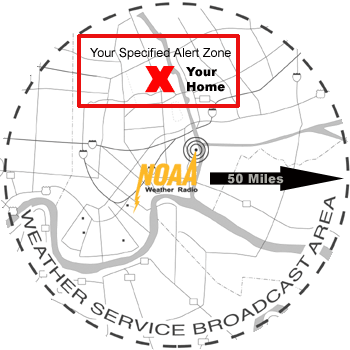
- Midland
Weather Alert Weather Radios
-
|
-
- S.A.M.E.
Weather Alert / Clock
|
-
- S.A.M.E.
Weather Alert AM / FM / Clock
|
| |
|
|
-
WEATHER
INFORMATION AND NOAA
Specific
Area
Message
Encoding
S.A.M.E.
- Is a feature in MIDLAND Weather Radios
that allows you to program in your county code or
counties codes. This will eliminate any
Alerts that are not within your programmed
Specific Area. For example, if you only
want to be informed for alerts within your county
just program in your county code. But, if
you want to be informed about counties that are
North, South, East and West of you, you can do
so.
Look at the image on the right.
|

|
EAS Event (NWR-SAME) Codes
|
| Weather-Related
Events |
NWR-SAME
Code
|
Status
|
| Blizzard Warning |
BZW
|
Operational
|
| Coastal Flood Watch |
CFA
|
NWS
implementation June 30, 2004
|
| Coastal Flood Warning |
CFW
|
NWS
implementation June 30, 2004
|
| Dust Storm Warning |
DSW
|
NWS
implementation June 30, 2004
|
| Flash Flood Watch |
FFA
|
Operational
|
| Flash Flood
Warning |
FFW
|
Operational
|
| Flash Flood
Statement |
FFS
|
Operational
|
| Flood Watch |
FLA
|
Operational
|
| Flood Warning |
FLW
|
Operational
|
| Flood Statement |
FLS
|
Operational
|
| High Wind Watch |
HWA
|
Operational
|
| High Wind Warning |
HWW
|
Operational
|
| Hurricane Watch |
HUA
|
Operational
|
| Hurricane Warning |
HUW
|
Operational
|
| Hurricane
Statement |
HLS
|
Operational
|
| Severe
Thunderstorm Watch |
SVA
|
Operational
|
| Severe
Thunderstorm Warning |
SVR
|
Operational
|
| Severe Weather
Statement |
SVS
|
Operational
|
| Special Marine Warning |
SMW
|
NWS
implementation June 30, 2004
|
| Special Weather
Statement |
SPS
|
Operational
|
| Tornado Watch |
TOA
|
Operational
|
| Tornado Warning |
TOR
|
Operational
|
| Tropical Storm Watch |
TRA
|
NWS
implementation June 30, 2004
|
| Tropical Storm Warning |
TRW
|
NWS
implementation June 30, 2004
|
| Tsunami Watch |
TSA
|
Operational
|
| Tsunami Warning |
TSW
|
Operational
|
| Winter Storm Watch |
WSA
|
Operational
|
| Winter Storm
Warning |
WSW
|
Operational
|
| |
| |
| Non-Weather-Related
Events |
NWR-SAME
Code
|
Status
|
| National
Codes-Required |
|
|
| Emergency Action
Notification |
EAN
|
Operational
|
| Emergency Action
Termination |
EAT
|
Operational
|
| National
Information Center |
NIC
|
Operational
|
| State and Local Codes-optional |
|
|
| Avalanche Watch |
AVA
|
NWS
implementation June 30, 2004
|
| Avalanche Warning |
AVW
|
NWS
implementation June 30, 2004
|
| Child Abduction Emergency |
CAE
|
NWS
implementation June 30, 2004
|
| Civil Danger Warning |
CDW
|
NWS
implementation June 30, 2004
|
| Civil Emergency
Message |
CEM
|
Operational
|
| Earthquake Warning |
EQW
|
NWS
implementation June 30, 2004
|
| Evacuation
Immediate |
EVI
|
Operational
|
| Fire Warning |
FRW
|
NWS
implementation June 30, 2004
|
| Hazardous Materials Warning |
HMW
|
NWS
implementation June 30, 2004
|
| Law Enforcement Warning |
LEW
|
NWS
implementation June 30, 2004
|
| Local Area Emergency |
LAE
|
NWS
implementation June 30, 2004
|
| 911 Telephone Outage Emergency |
TOE
|
NWS
implementation June 30, 2004
|
| Nuclear Power Plant Warning |
NUW
|
NWS
implementation June 30, 2004
|
| Radiological Hazard Warning |
RHW
|
NWS
implementation June 30, 2004
|
| Shelter in Place Warning |
SPW
|
NWS
implementation June 30, 2004
|
| Volcano Warning |
VOW
|
NWS
implementation June 30, 2004
|
| |
| Administrative Events |
NWR-SAME
Code
|
Status
|
| Administrative
Message |
ADR
|
Operational
|
| National Periodic
Test |
NPT
|
Operational
|
| Network Message Notification |
NMN
|
NWS
implementation June 30, 2004
|
| Practice/Demo
Warning |
DMO
|
Operational
|
| Required Monthly
Test |
RMT
|
Operational
|
| Required Weekly
Test |
RWT
|
Operational
|
A WARNING is an
event that alone poses a significant threat to public
safety and/or property, probability of occurrence and
location is high, and the onset time is relatively short.
A WATCH meets the classification of a warning, but
either the onset time, probability of occurrence, or
location is uncertain.
An EMERGENCY is an event that, by itself, would
not kill or injure or do property damage, but indirectly
may cause other things to happen that result in a hazard.
For example, a major power or telephone loss in a large
city alone is not a direct hazard, but disruption to
other critical services could create a variety of
conditions that could directly threaten public safety.
A STATEMENT is a message containing follow up
information to a warning, watch, or emergency.
-
-
|